Super Resolution of Satellite-Based Land Surface Temperature Through Airborne Thermal Imaging
Highlights
- A novel Dilated Spatio-Temporal U-Net (DST-UNet) model successfully downscales low-resolution satellite thermal imagery to airborne-quality thermal maps by capturing multiscale urban thermal patterns and demonstrates effective generalization across diverse urban environments.
- Municipalities can conduct continuous high-resolution urban thermal monitoring from open-source satellite data at significantly reduced costs, overcoming temporal limitations of airborne campaigns and the resolution gap between optical and thermal sensors.
- This scalable framework enables more frequent urban heat island assessments, supporting improved climate resilience strategies and public health interventions against heat-related threats.
Abstract
1. Introduction
2. Related Works
3. Methodology
3.1. Super Resolution Model Definition
3.2. Data Pre-Processing
- the orthophoto was resampled by median from 0.1 to 0.5 m for each of the RGBI channels;
- the radiance measured at the airborne sensor was corrected to the actual LST on the ground [51];
- the raw Landsat scenes were corrected following Ermida et al. (2020) [50] procedure;
- land cover classification map was retrieved from hyperspectral images following Valentin (2019) [53] on a pixel-based random forest classification method.
3.3. Parameter Settings
- Root mean square error (RMSE): it calculates the square root of the average squared difference between the predicted and the reference image:
- Peak signal-to-noise ratio (PSNR): it is an expression for the ratio between the maximum possible value of a signal and the power of distorting noise that affects the quality of its representation:
- Structural similarity index measure (SSIM): SSIM [56] is a method that measures the similarity between two images:
3.4. Model Comparison with Existing Super Resolution Deep Learning Models
3.5. Model Refinement
3.6. Model Cross-Validation and Re-Training
4. Results
4.1. Airborne and Satellite Thermal Imaging Comparison
4.2. DST-UNET Model Applied to Thermal Imaging
4.3. DST-UNET Model Refinement with Emissivity Maps
4.4. DST-UNET Model Cross-Validation Results and Re-Training
5. Discussion
5.1. Methodological Limitations and Constraints
5.2. Implications for Urban Climate Monitoring
6. Conclusions
Author Contributions
Funding
Data Availability Statement
Conflicts of Interest
References
- Milesi, C.; Churkina, G. Measuring and Monitoring Urban Impacts on Climate Change from Space. Remote Sens. 2020, 12, 3494. [Google Scholar] [CrossRef]
- Kasniza Jumari, N.A.S.; Ahmed, A.N.; Huang, Y.F.; Ng, J.L.; Koo, C.H.; Chong, K.L.; Sherif, M.; Elshafie, A. Analysis of Urban Heat Islands with Landsat Satellite Images and GIS in Kuala Lumpur Metropolitan City. Heliyon 2023, 9, e18424. [Google Scholar] [CrossRef]
- Guo, J.; Hong, D.; Zhu, X.X. High-Resolution Satellite Images Reveal the Prevalent Positive Indirect Impact of Urbanization on Urban Tree Canopy Coverage in South America. Landsc. Urban Plan. 2024, 247, 105076. [Google Scholar] [CrossRef]
- Amado, M.P.; Poggi, F. Sustainable Energy Transition for Cities; Elsevier: Amsterdam, The Netherlands, 2022; ISBN 978-0-12-824277-3. [Google Scholar]
- David, M.G.; Dietrich, M.; Raczko, N.; Denvil, S.; Santoro, M.; Chatzikyriakou, C.; Borejko, W. Towards the European Green Deal Data Space. In Proceedings of the EGU General Assembly 2023, Vienna, Austria, 24–28 April 2023. [Google Scholar]
- Deng, J.S.; Wang, K.; Hong, Y.; Qi, J.G. Spatio-Temporal Dynamics and Evolution of Land Use Change and Landscape Pattern in Response to Rapid Urbanization. Landsc. Urban Plan. 2009, 92, 187–198. [Google Scholar] [CrossRef]
- Li, L.; Zhao, K.; Wang, X.; Zhao, S.; Liu, X.; Li, W. Spatio-Temporal Evolution and Driving Mechanism of Urbanization in Small Cities: Case Study from Guangxi. Land 2022, 11, 415. [Google Scholar] [CrossRef]
- Liu, Y.; Yusof, M.J.M.; Rehan, B.M.; Kasim, J.A. Assessment of the Spatio-Temporal Dynamics in Urban Green Space via Intensity Analysis and Landscape Pattern Indices: A Case Study of Taiyuan, China. Sustainability 2024, 16, 8363. [Google Scholar] [CrossRef]
- Kumar, P.; Debele, S.E.; Khalili, S.; Halios, C.H.; Sahani, J.; Aghamohammadi, N.; Andrade, M.D.F.; Athanassiadou, M.; Bhui, K.; Calvillo, N.; et al. Urban Heat Mitigation by Green and Blue Infrastructure: Drivers, Effectiveness, and Future Needs. Innovation 2024, 5, 100588. [Google Scholar] [CrossRef]
- Ma, J.; Zhou, J.; Zhang, T.; Tang, W.; Wang, Y. A Comprehensive Validation Scheme for Satellite-Derived Land Surface Temperature Dataset. IEEE Trans. Geosci. Remote Sens. 2024, 62, 1–12. [Google Scholar] [CrossRef]
- Sheehan, A.; Beddows, A.; Gulliver, J.; Green, D.C.; Beevers, S. Estimating Road Vehicle Speed from High-Resolution Satellite Imagery for Environmental Applications: A Case Study of Barcelona. Remote Sens. Appl. Soc. Environ. 2025, 37, 101507. [Google Scholar] [CrossRef]
- Gerke, M.; Nex, F.; Remondino, F.; Jacobsen, K.; Kremer, J.; Karel, W.; Hu, H.; Ostrowski, W. Orientation of Oblique Airborne Image Sets—Experiences from the ISPRS/EUROSDR Benchmark on Multi-Platform Photogrammetry. Int. Arch. Photogramm. Remote Sens. Spat. Inf. Sci. 2016, 41, 185–191. [Google Scholar] [CrossRef]
- Sobrino, J.A.; Del Frate, F.; Drusch, M.; Jimenez-Munoz, J.C.; Manunta, P.; Regan, A. Review of Thermal Infrared Applications and Requirements for Future High-Resolution Sensors. IEEE Trans. Geosci. Remote Sens. 2016, 54, 2963–2972. [Google Scholar] [CrossRef]
- Wang, Y.; Li, J.; Sun, H.; Li, X. A Review on the Developments and Space Applications of Mid- and Long-Wavelength Infrared Detection Technologies. Front. Inf. Technol. Electron. Eng. 2024, 25, 1031–1056. [Google Scholar] [CrossRef]
- SatVu. Thermal Imagery. Available online: https://www.satellitevu.com/products/thermal-imagery (accessed on 26 September 2025).
- Yang, J.; Shi, Q.; Menenti, M.; Wong, M.S.; Wu, Z.; Zhao, Q.; Abbas, S.; Xu, Y. Observing the Impact of Urban Morphology and Building Geometry on Thermal Environment by High Spatial Resolution Thermal Images. Urban Clim. 2021, 39, 100937. [Google Scholar] [CrossRef]
- ESA. Sentinel-3 SLSTR. Available online: https://sentiwiki.copernicus.eu/__attachments/1672112/OMPC.ACR.HBK.002%20-%20Sentinel%203%20SLSTR%20Land%20Handbook%202024%20-%201.4.pdf?inst-v=96021aea-734a-44d2-9ca8-2228c7de7290 (accessed on 26 September 2025).
- NASA MODIS—Moderate Resolution Imaging Spectroradiometer. Available online: https://www.earthdata.nasa.gov/data/instruments/modis (accessed on 26 September 2025).
- USGS Landsat 8 (L8) Data Users Handbook. Available online: https://d9-wret.s3.us-west-2.amazonaws.com/assets/palladium/production/s3fs-public/atoms/files/LSDS-1574_L8_Data_Users_Handbook-v5.0.pdf (accessed on 26 September 2025).
- NASA. ECOSTRESS. Available online: https://ecostress.jpl.nasa.gov/mission (accessed on 26 September 2025).
- IGI Dual-DigiTHERM. Available online: https://www.igi-systems.com/dual-digitherm.html (accessed on 26 September 2025).
- Kapil, R.; Castilla, G.; Marvasti-Zadeh, S.M.; Goodsman, D.; Erbilgin, N.; Ray, N. Orthomosaicking Thermal Drone Images of Forests via Simultaneously Acquired RGB Images. Remote Sens. 2023, 15, 2653. [Google Scholar] [CrossRef]
- Amidror, I. Scattered Data Interpolation Methods for Electronic Imaging Systems: A Survey. J. Electron. Imaging 2002, 11, 157. [Google Scholar] [CrossRef]
- Keys, R. Cubic Convolution Interpolation for Digital Image Processing. IEEE Trans. Acoust. Speech Signal Process. 1981, 29, 1153–1160. [Google Scholar] [CrossRef]
- Bovik, A.C. The Essential Guide to Image Processing; Elsevier: Amsterdam, The Netherlands, 2009; ISBN 978-0-12-374457-9. [Google Scholar]
- Duchon, C.E. Lanczos Filtering in One and Two Dimensions. J. Appl. Meteorol. 1979, 18, 1016–1022. [Google Scholar] [CrossRef]
- Ledig, C.; Theis, L.; Huszar, F.; Caballero, J.; Cunningham, A.; Acosta, A.; Aitken, A.; Tejani, A.; Totz, J.; Wang, Z.; et al. Photo-Realistic Single Image Super-Resolution Using a Generative Adversarial Network. In Proceedings of the IEEE Conference on Computer Vision and Pattern Recognition, Honolulu, HI, USA, 21–26 July 2017. [Google Scholar]
- Lim, B.; Son, S.; Kim, H.; Nah, S.; Lee, K.M. Enhanced Deep Residual Networks for Single Image Super-Resolution. In Proceedings of the IEEE Conference on Computer Vision and Pattern Recognition Workshops, Honolulu, HI, USA, 21–26 July 2017. [Google Scholar]
- Yu, J.; Fan, Y.; Yang, J.; Xu, N.; Wang, Z.; Wang, X.; Huang, T. Wide Activation for Efficient and Accurate Image Super-Resolution. arXiv 2018, arXiv:1808.08718. [Google Scholar] [CrossRef]
- Zhang, K.; Li, Y.; Liang, J.; Cao, J.; Zhang, Y.; Tang, H.; Fan, D.-P.; Timofte, R.; Gool, L.V. Practical Blind Image Denoising via Swin-Conv-UNet and Data Synthesis. Mach. Intell. Res. 2023, 20, 822–836. [Google Scholar] [CrossRef]
- Liu, Z.; Lin, Y.; Cao, Y.; Hu, H.; Wei, Y.; Zhang, Z.; Lin, S.; Guo, B. Swin Transformer: Hierarchical Vision Transformer Using Shifted Windows. In Proceedings of the IEEE/CVF International Conference on Computer Vision, Montreal, QC, Canada, 10–17 October 2021. [Google Scholar]
- Ronneberger, O.; Fischer, P.; Brox, T. U-Net: Convolutional Networks for Biomedical Image Segmentation. In Medical Image Computing and Computer-Assisted Intervention—MICCAI 2015; Navab, N., Hornegger, J., Wells, W.M., Frangi, A.F., Eds.; Springer International Publishing: Cham, Switzerland, 2015; Volume 9351, pp. 234–241. ISBN 978-3-319-24573-7. [Google Scholar]
- Zhang, Y.; Li, K.; Li, K.; Wang, L.; Zhong, B.; Fu, Y. Image Super-Resolution Using Very Deep Residual Channel Attention Networks. In Proceedings of the European Conference on Computer Vision (ECCV), Munich, Germany, 8–14 September 2018. [Google Scholar]
- Lai, W.-S.; Huang, J.-B.; Ahuja, N.; Yang, M.-H. Deep Laplacian Pyramid Networks for Fast and Accurate Super-Resolution. In Proceedings of the IEEE Conference on Computer Vision and Pattern Recognition, Honolulu, HI, USA, 21–26 July 2017. [Google Scholar]
- Kim, J.; Lee, J.K.; Lee, K.M. Accurate Image Super-Resolution Using Very Deep Convolutional Networks. In Proceedings of the 2016 IEEE Conference on Computer Vision and Pattern Recognition (CVPR), Las Vegas, NV, USA, 27–30 June 2016; pp. 1646–1654. [Google Scholar]
- Demiray, B.Z.; Sit, M.; Demir, I. D-SRGAN: DEM Super-Resolution with Generative Adversarial Networks. arXiv 2020, arXiv:2004.04788. [Google Scholar] [CrossRef]
- Pashaei, M.; Starek, M.J.; Kamangir, H.; Berryhill, J. Deep Learning-Based Single Image Super-Resolution: An Investigation for Dense Scene Reconstruction with UAS Photogrammetry. Remote Sens. 2020, 12, 1757. [Google Scholar] [CrossRef]
- Shin, D.; Spittle, S. LoGSRN: Deep Super Resolution Network for Digital Elevation Model. In Proceedings of the 2019 IEEE International Conference on Systems, Man and Cybernetics (SMC), Bari, Italy, 6–9 October 2019; pp. 3060–3065. [Google Scholar]
- Jiao, D.; Wang, D.; Lv, H.; Peng, Y. Super-Resolution Reconstruction of a Digital Elevation Model Based on a Deep Residual Network. Open Geosci. 2020, 12, 1369–1382. [Google Scholar] [CrossRef]
- Zhang, R.; Bian, S.; Li, H. RSPCN: Super-Resolution of Digital Elevation Model Based on Recursive Sub-Pixel Convolutional Neural Networks. ISPRS Int. J. Geo-Inf. 2021, 10, 501. [Google Scholar] [CrossRef]
- Shi, W.; Caballero, J.; Huszár, F.; Totz, J.; Aitken, A.P.; Bishop, R.; Rueckert, D.; Wang, Z. Real-Time Single Image and Video Super-Resolution Using an Efficient Sub-Pixel Convolutional Neural Network. In Proceedings of the IEEE Conference on Computer Vision and Pattern Recognition, Las Vegas, NV, USA, 27–30 June 2016. [Google Scholar]
- Huryna, H.; Cohen, Y.; Karnieli, A.; Panov, N.; Kustas, W.; Agam, N. Evaluation of TsHARP Utility for Thermal Sharpening of Sentinel-3 Satellite Images Using Sentinel-2 Visual Imagery. Remote Sens. 2019, 11, 2304. [Google Scholar] [CrossRef]
- Lacerda, L.N.; Cohen, Y.; Snider, J.; Huryna, H.; Liakos, V.; Vellidis, G. Field Scale Assessment of the TsHARP Technique for Thermal Sharpening of MODIS Satellite Images Using VENµS and Sentinel-2-Derived NDVI. Remote Sens. 2021, 13, 1155. [Google Scholar] [CrossRef]
- Onačillová, K.; Gallay, M.; Paluba, D.; Péliová, A.; Tokarčík, O.; Laubertová, D. Combining Landsat 8 and Sentinel-2 Data in Google Earth Engine to Derive Higher Resolution Land Surface Temperature Maps in Urban Environment. Remote Sens. 2022, 14, 4076. [Google Scholar] [CrossRef]
- Jaafar, H.; Mourad, R.; Schull, M. A Global 30-m ET Model (HSEB) Using Harmonized Landsat and Sentinel-2, MODIS and VIIRS: Comparison to ECOSTRESS ET and LST. Remote Sens. Environ. 2022, 274, 112995. [Google Scholar] [CrossRef]
- Bahi, H.; Bounoua, L.; Sabri, A.; Bannari, A.; Malah, A.; Rhinane, H. A New Thermal Fusion Method to Downscale Land Surface Temperature to Finer Spatial Resolution Using Sentinel-MSI and Landsat-OLI/TIRS Imagery. Remote Sens. Appl. Soc. Environ. 2025, 37, 101519. [Google Scholar] [CrossRef]
- Xue, J.; Anderson, M.C.; Gao, F.; Hain, C.; Sun, L.; Yang, Y.; Knipper, K.R.; Kustas, W.P.; Torres-Rua, A.; Schull, M. Sharpening ECOSTRESS and VIIRS Land Surface Temperature Using Harmonized Landsat-Sentinel Surface Reflectances. Remote Sens. Environ. 2020, 251, 112055. [Google Scholar] [CrossRef]
- Hurduc, A.; Ermida, S.L.; DaCamara, C.C. A Multi-Layer Perceptron Approach to Downscaling Geostationary Land Surface Temperature in Urban Areas. Remote Sens. 2024, 17, 45. [Google Scholar] [CrossRef]
- Beber, R.; Perda, G.; Takhtkeshha, N.; Remondino, F.; Maffei, T.; Poli, D.; Moe, K.; Cipriano, P.; Ciliberti, M. Multi-Modal Geospatial and Thematic Data to Foster Green Deal Applications. Int. Arch. Photogramm. Remote Sens. Spat. Inf. Sci. 2023, 48, 9–16. [Google Scholar] [CrossRef]
- Ermida, S.L.; Soares, P.; Mantas, V.; Göttsche, F.-M.; Trigo, I.F. Google Earth Engine Open-Source Code for Land Surface Temperature Estimation from the Landsat Series. Remote Sens. 2020, 12, 1471. [Google Scholar] [CrossRef]
- Rüdisser, D.; Posch, T.; Sulzer, W. The GRAZ Method—Determination of Urban Surface Temperatures from Aerial Thermography Based on a Three-Dimensional Sampling Algorithm. Remote Sens. 2024, 16, 3949. [Google Scholar] [CrossRef]
- Yu, F.; Koltun, V. Multi-Scale Context Aggregation by Dilated Convolutions. arXiv 2015, arXiv:1511.07122. [Google Scholar]
- Valentin, Ș. Exercise with Pixel Based Supervised Classification of Sentinel-2 Multispectral Images in R. Comparing Random Forests, SVM and Neural Networks. Zenodo 2019. [Google Scholar] [CrossRef]
- Beber, R.; Maffei, T.; Malek, S.; Poli, D.; Remondino, F. Fusion of Airborne and Spaceborne Thermal Imagery for Temperature Monitoring in Urban Areas. In Geographic Approaches to Climate Change and Mitigation: Urban and Rural Perspectives, Proceedings of the International Conference on Geographic Perspectives on Climate Change Mitigation in Urban and Rural Environments, Roma, Italy, 25–27 November 2025; Mohammad, P., Shahfahad, Comino, J.R., Matamanda, A.R., Eds.; Springer Nature: Cham, Switzerland, 2025; Volume 1, pp. 73–81. [Google Scholar] [CrossRef]
- Kingma, D.P.; Ba, J. Adam: A Method for Stochastic Optimization. arXiv 2014. [Google Scholar] [CrossRef]
- Wang, Z.; Bovik, A.C.; Sheikh, H.R.; Simoncelli, E.P. Image Quality Assessment: From Error Visibility to Structural Similarity. IEEE Trans. Image Process. 2004, 13, 600–612. [Google Scholar] [CrossRef]
- GitHub VDSR-PyTorch. Available online: https://github.com/Lornatang/VDSR-PyTorch (accessed on 26 September 2025).
- GitHub VDSR4DEM. Available online: https://github.com/OpenDEM/VDSR4DEM (accessed on 26 September 2025).
- Pir Mohammad, S.; Comino, J.R.; Matamanda, A.R. Geographic Approaches to Climate Change and Mitigation: Urban and Rural.; Springer International PU: Berlin/Heidelberg, Germany, 2025; ISBN 978-3-031-92118-6. [Google Scholar]
- ESA Copernicus LSTM. Available online: https://sentinels.copernicus.eu/copernicus/lstm (accessed on 26 September 2025).
- CNES-ISRO TRISHNA. Available online: https://cnes.fr/en/projects/trishna (accessed on 26 September 2025).
- NASA-ASI SBG-TIR. Available online: https://database.eohandbook.com/database/missionsummary.aspx?missionID=975 (accessed on 26 September 2025).
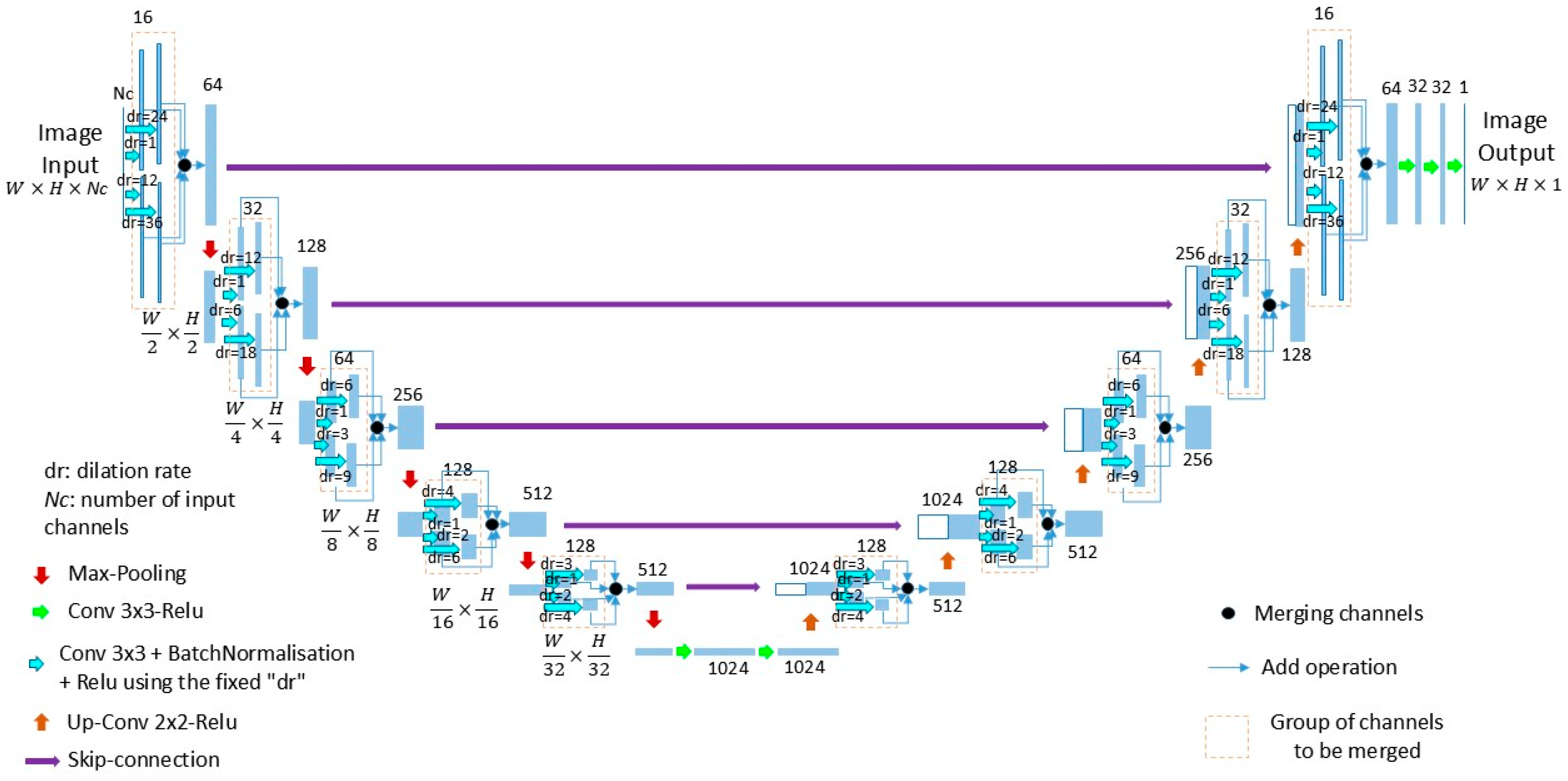
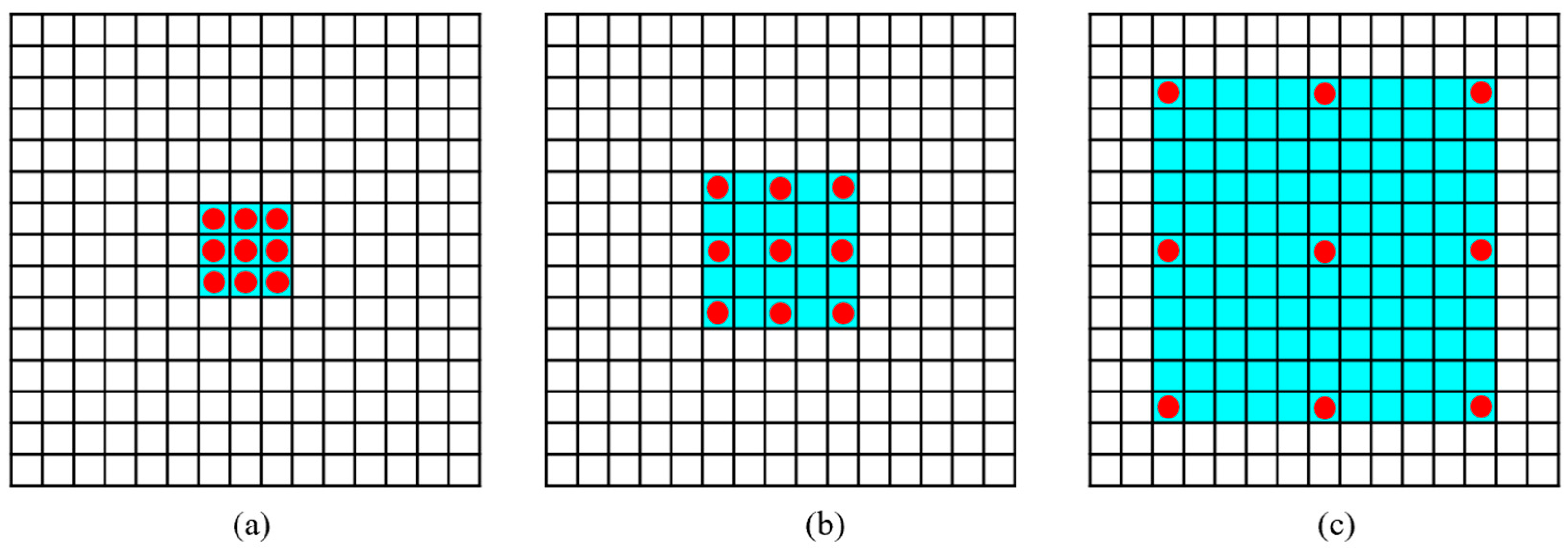


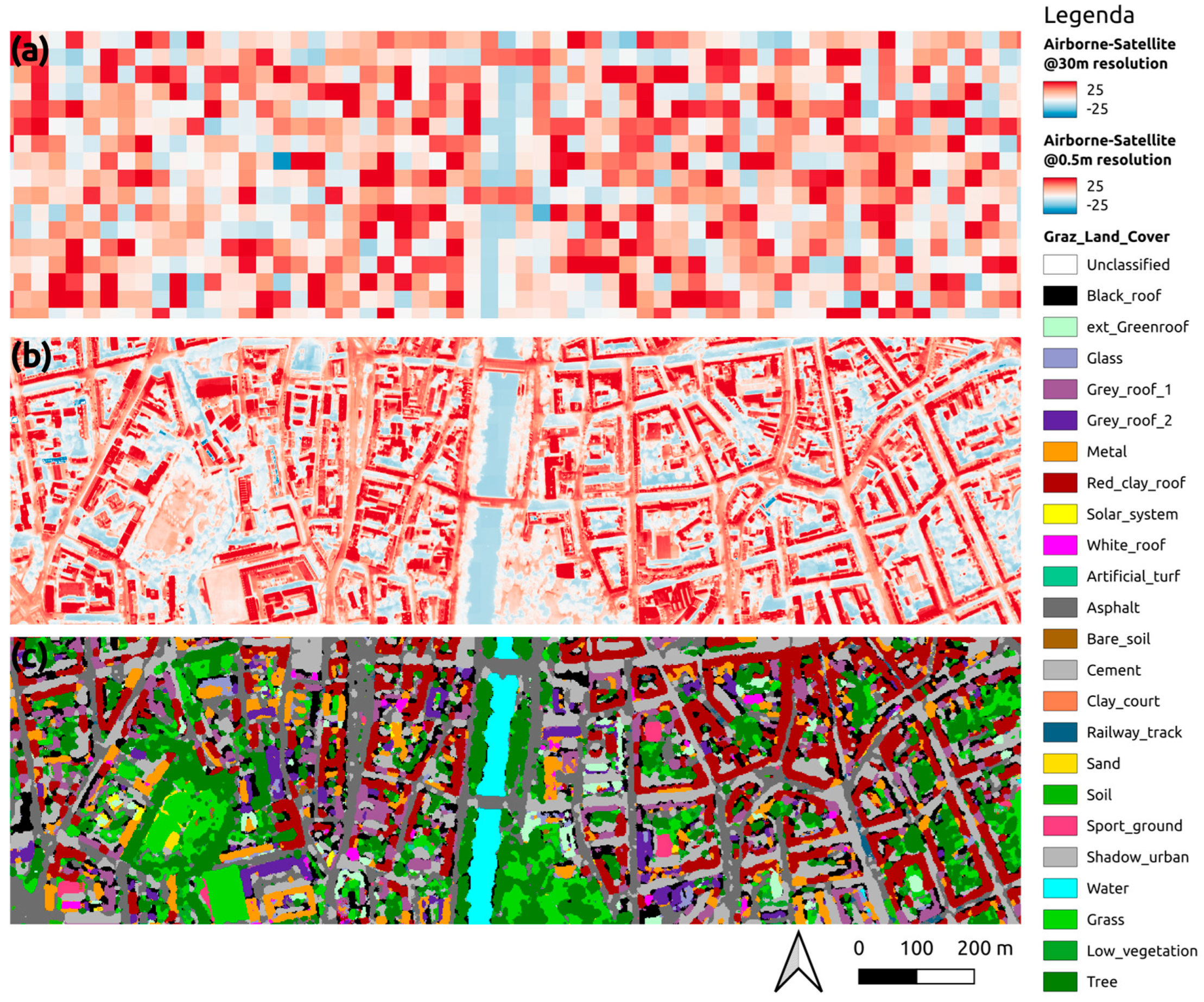
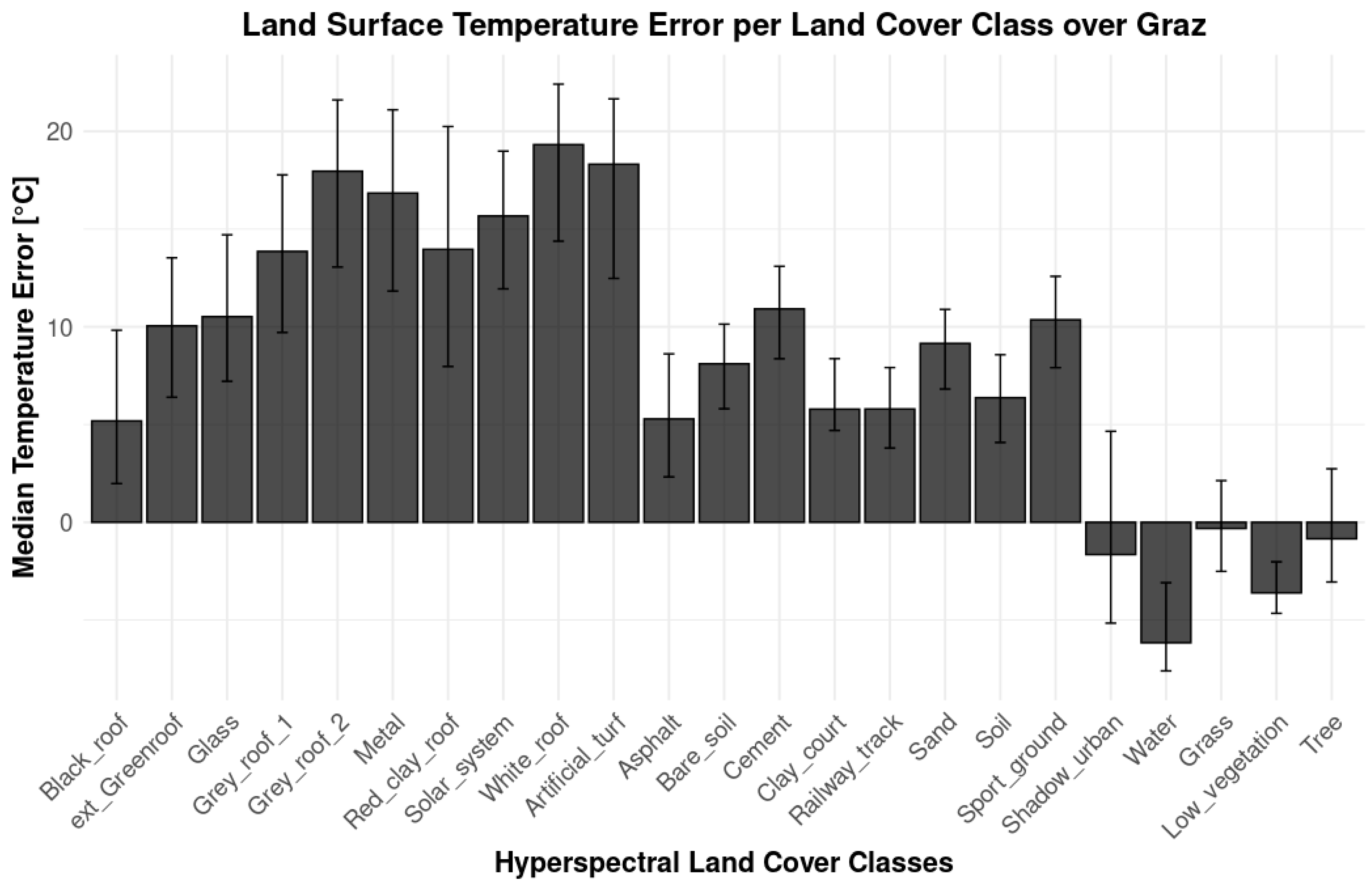
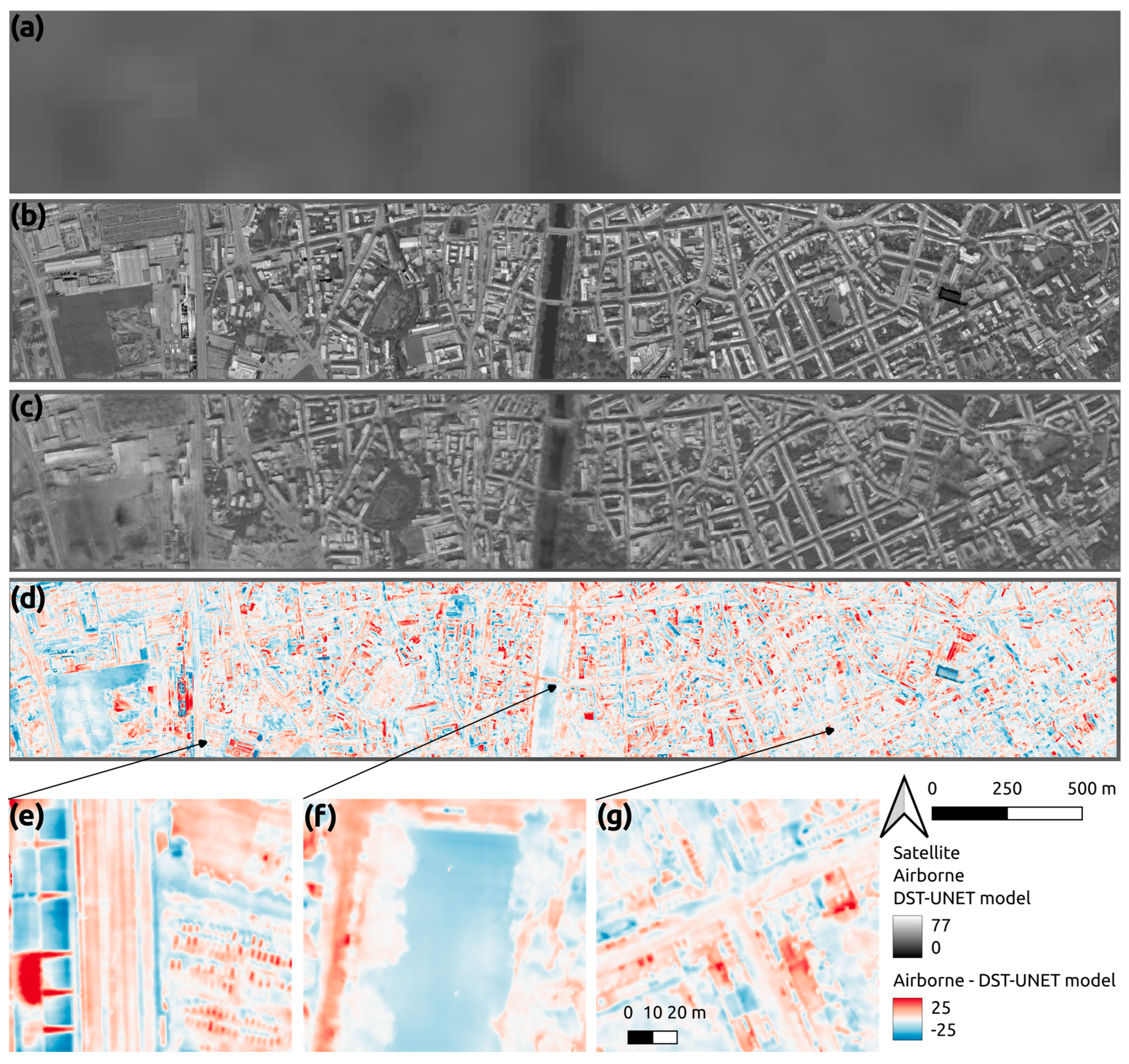
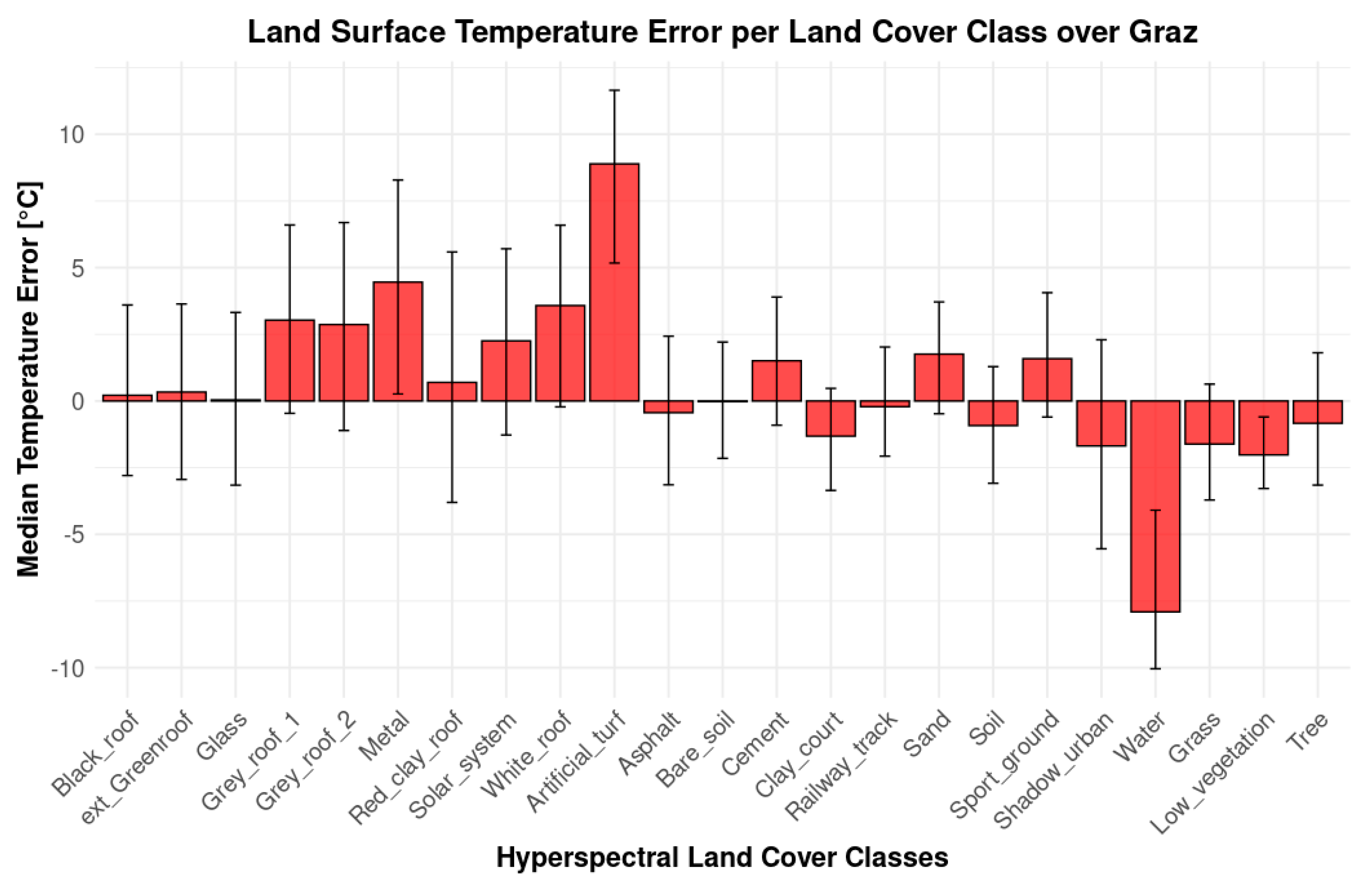

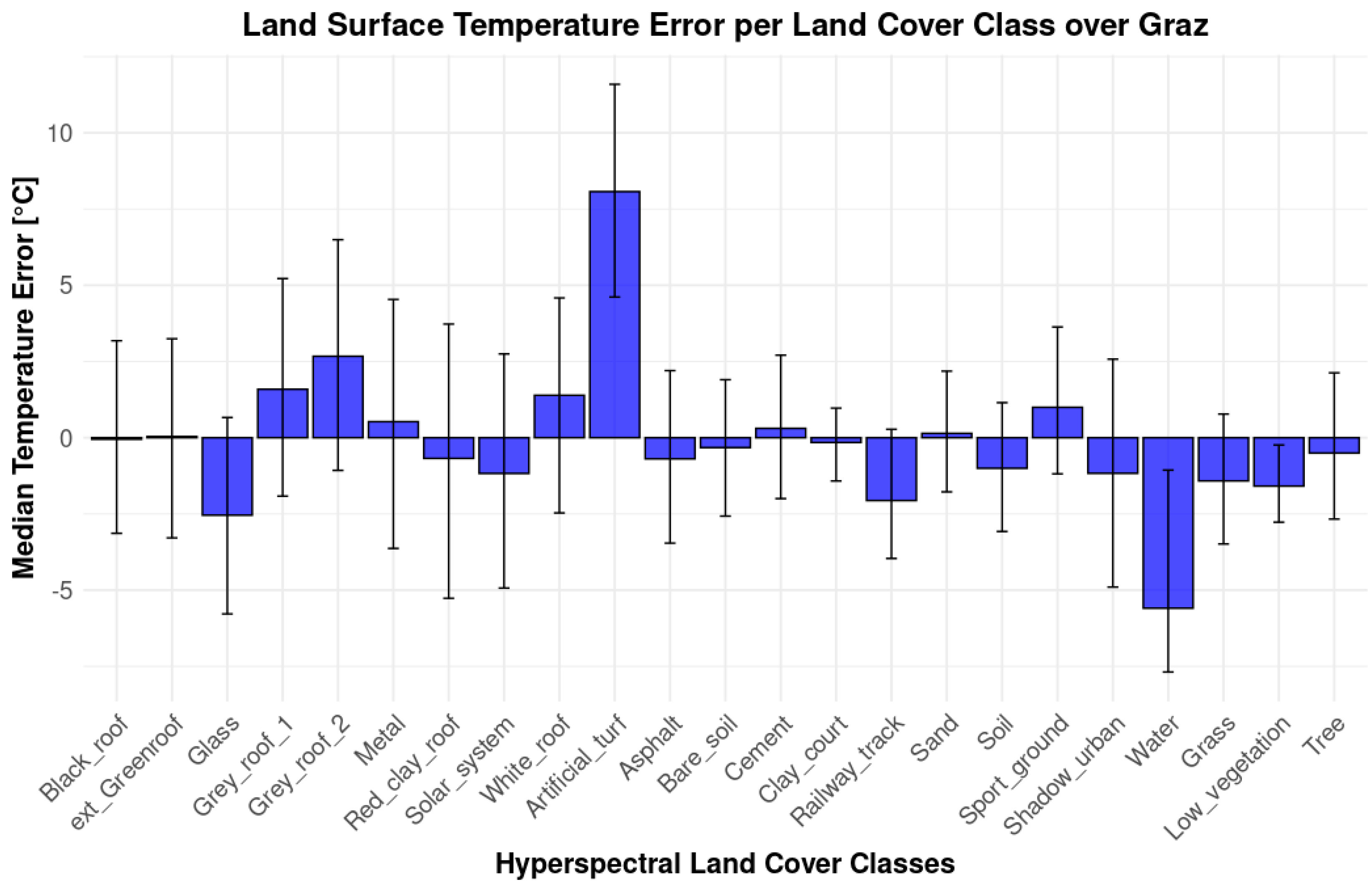
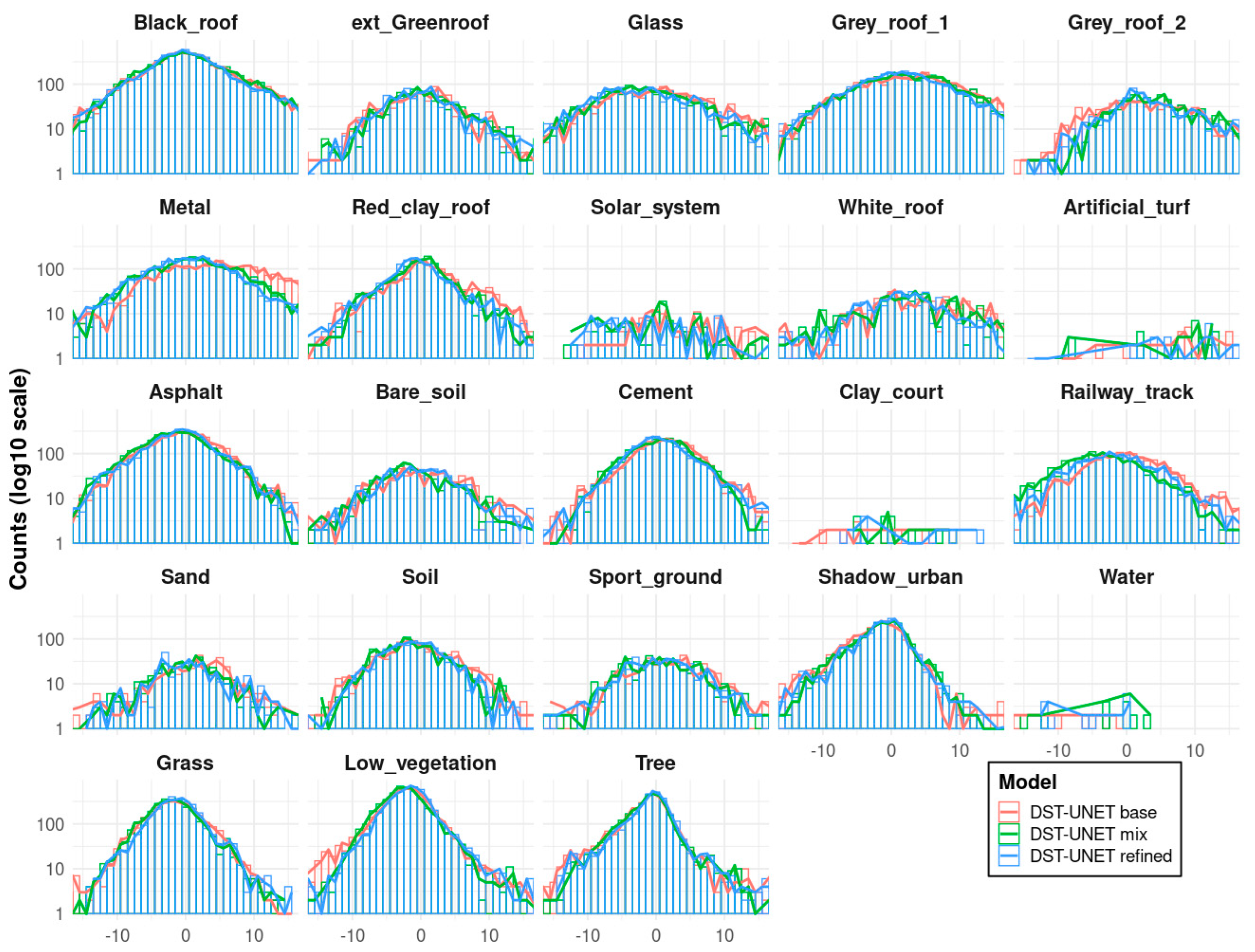


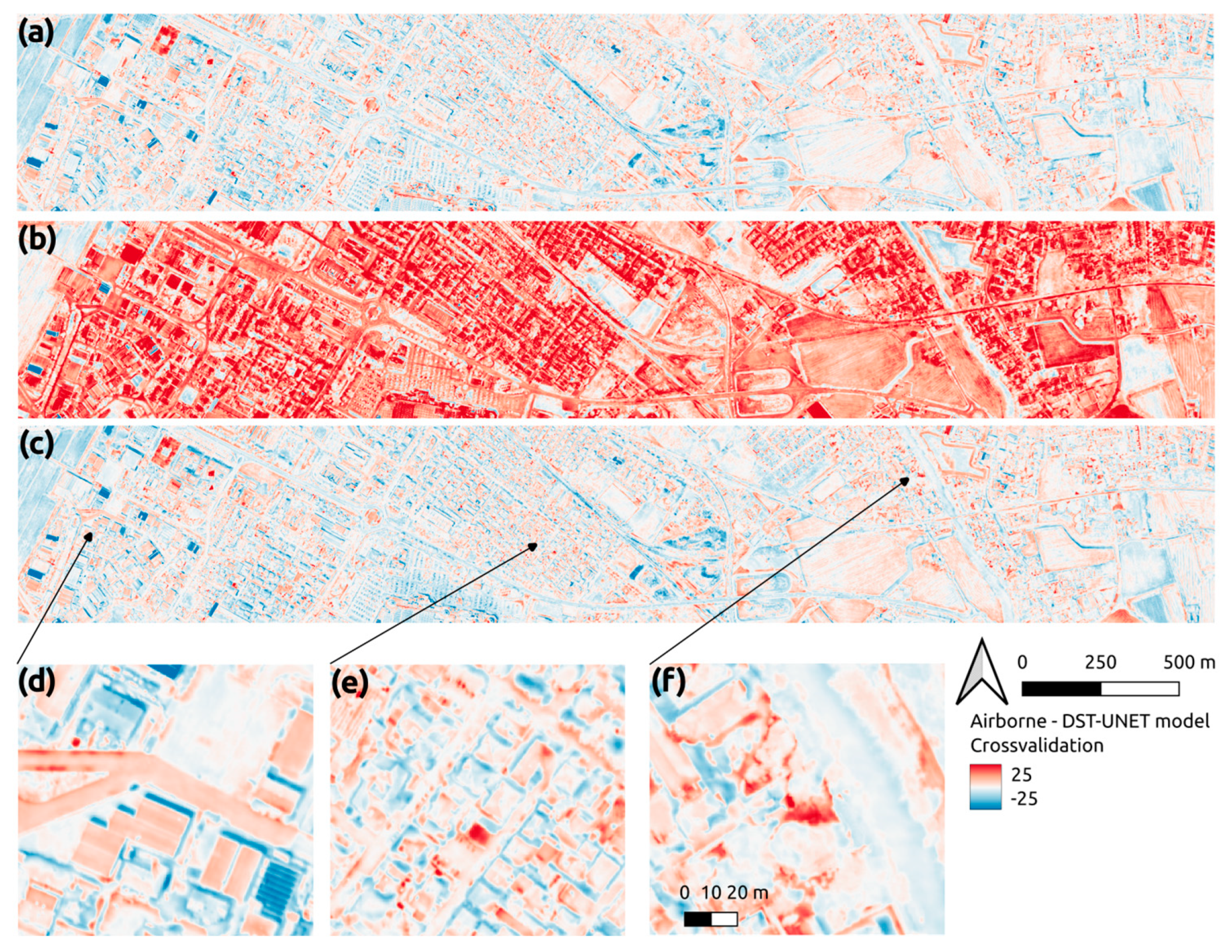
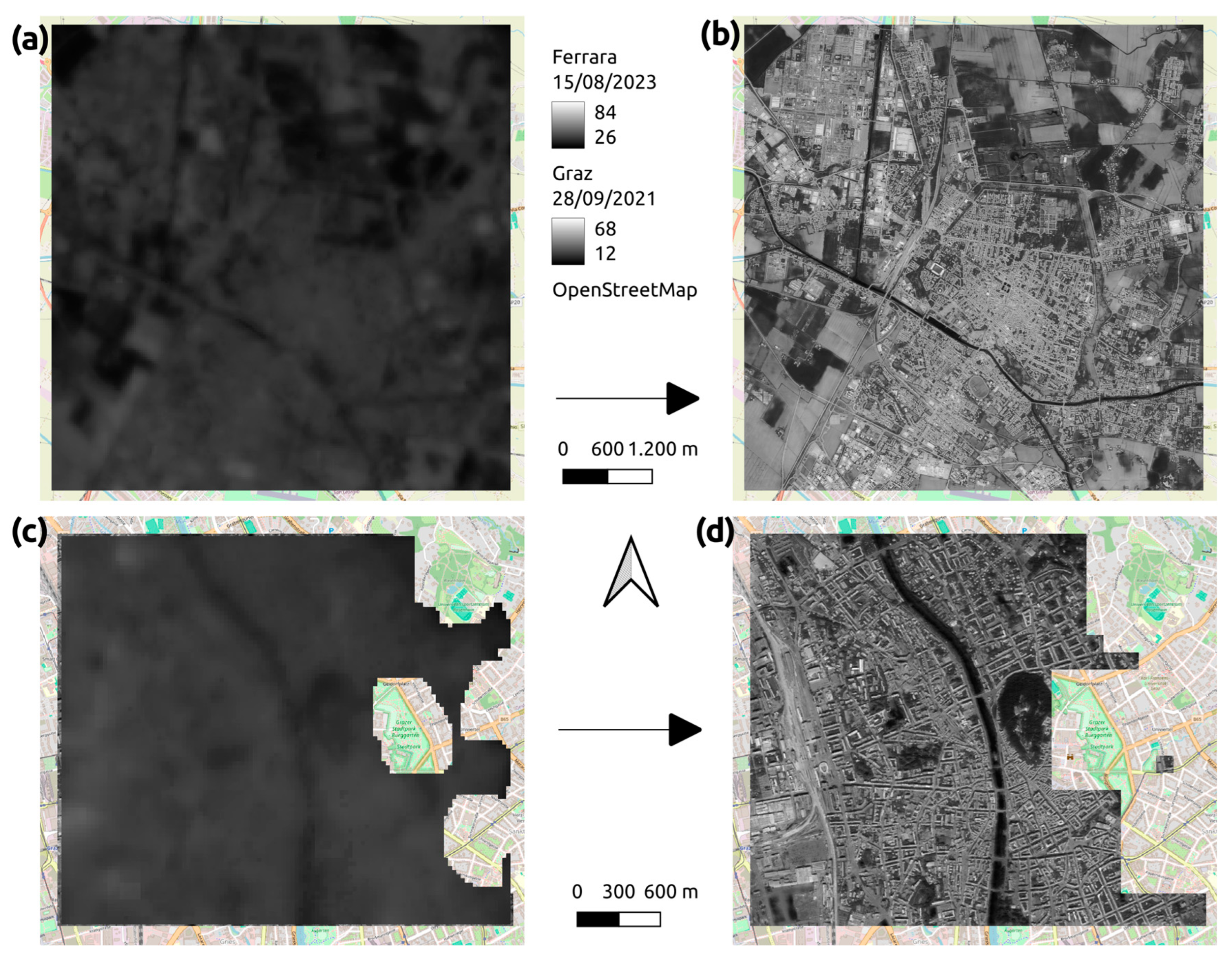
| Platform | Sensor | Spatial Resolution | # Thermal Bands | Thermal Range [µm] | Revisit Time |
|---|---|---|---|---|---|
| Sentinel-3 (A&B) [17] | SLSTR | 1 km | 3 | 3.7–12.0 | ~1 day |
| Terra and Aqua [18] | MODIS | 1 km | 16 | 3.6–14.4 | 1 day |
| Landsat (8&9) [19] | TIRS | 100 m | 2 | 10.0–12.5 | 8 days |
| ISS [20] | ECOSTRESS | 70 m | 5 | 8.0–12.7 | ~4 days (on-demand) |
| HotSat-1 [15] | MWIR | 3.5 m | 1 | 3.7–5.0 | on-demand |
| aeroplane [21] | 2x DigiTHERM- 1024 | 0.5–1 m | 1 | 7.5–14.0 | on-demand |
| Drone [22] | Zenmuse H20T | 0.1–0.2 m | 1 | 8.0–14.0 | on-demand |
| Data | Ferrara, Italy | Graz, Austria |
|---|---|---|
| Airborne Thermal [local time] | DigiTHERM 16 July 2023 [14:35–16:00] | DigiTHERM 9 September 2021 [13:15–15:05] |
| Airborne Hyperspectral | 2022 | 2021 |
| Airborne Multispectral | 2022 | 2021 |
| Satellite scenes | LC08_L2SP_192029_20230714_20230724_02_T1LC08_L2SP_192029_20230815_20230819_02_T1 | LC08_L2SP_190027_20210912_20210916_02_T1LC08_L2SP_190027_20210928_20211001_02_T1 |
| LST-satellite | Corrected as Ermida et al., 2020 [50] | |
| LST-airborne | Corrected as Rüdisser et al., 2024 [51] | |
| Orthophotos | OrthoRectification of multispectral airborne imagery acquired with a Vexel UltraCam Osprey 4.1 | |
| Land Cover | Random Forest classification of Hyperspectral images acquired with a Specim AisaFENIX384 | |
| Emissivity map | Look up tables from Land Cover map | |
| Graz Testing Part (20%) | |||
|---|---|---|---|
| Super Resolution from 30 m to 50 cm | RMSE ↓ [°C] | PSNR ↑ [dB] | SSIM ↑ % (100) |
| Linear | 13.34 | 21.76 | 60 |
| VDSR [57] | 6.59 | 21.68 | 71.68 |
| VDSR4DEM [58] | 7.04 | 21.1 | 70.56 |
| EDSR [28] | 10.47 | 17.65 | 60.74 |
| Graz model | 6.44 | 21.88 | 74.44 |
| Ferrara model | 10.48 | 17.66 | 61.84 |
| Graz model (refined) | 6.22 | 22.19 | 75.15 |
| Ferrara model (refined) | 9.98 | 18.08 | 62.65 |
| Graz_Ferrara_model (mix) | 6.35 | 22 | 73.66 |
| Ferrara testing part (20%) | |||
| Super Resolution from 30 m to 50 cm | RMSE ↓ [°C] | PSNR ↑ [dB] | SSIM ↑ % (100) |
| Linear | 18 | 12.69 | 64.56 |
| VDSR [57] | 5.78 | 22.83 | 76.34 |
| VDSR4DEM [58] | 6.09 | 22.37 | 75.13 |
| EDSR [28] | 8.02 | 19.97 | 68.23 |
| Graz model | 13.46 | 15.48 | 67.8 |
| Ferrara model | 5.6 | 23.1 | 76.9 |
| Graz model (refined) | 16.43 | 13.75 | 68.57 |
| Ferrara model (refined) | 5.36 | 23.47 | 77.78 |
| Graz_Ferrara_model (mix) | 5.55 | 23.17 | 77.82 |
Disclaimer/Publisher’s Note: The statements, opinions and data contained in all publications are solely those of the individual author(s) and contributor(s) and not of MDPI and/or the editor(s). MDPI and/or the editor(s) disclaim responsibility for any injury to people or property resulting from any ideas, methods, instructions or products referred to in the content. |
© 2025 by the authors. Licensee MDPI, Basel, Switzerland. This article is an open access article distributed under the terms and conditions of the Creative Commons Attribution (CC BY) license (https://creativecommons.org/licenses/by/4.0/).
Share and Cite
Raniero, R.; Malek, S.; Remondino, F. Super Resolution of Satellite-Based Land Surface Temperature Through Airborne Thermal Imaging. Remote Sens. 2025, 17, 3766. https://doi.org/10.3390/rs17223766
Raniero R, Malek S, Remondino F. Super Resolution of Satellite-Based Land Surface Temperature Through Airborne Thermal Imaging. Remote Sensing. 2025; 17(22):3766. https://doi.org/10.3390/rs17223766
Chicago/Turabian StyleRaniero, Raniero, Salim Malek, and Fabio Remondino. 2025. "Super Resolution of Satellite-Based Land Surface Temperature Through Airborne Thermal Imaging" Remote Sensing 17, no. 22: 3766. https://doi.org/10.3390/rs17223766
APA StyleRaniero, R., Malek, S., & Remondino, F. (2025). Super Resolution of Satellite-Based Land Surface Temperature Through Airborne Thermal Imaging. Remote Sensing, 17(22), 3766. https://doi.org/10.3390/rs17223766







